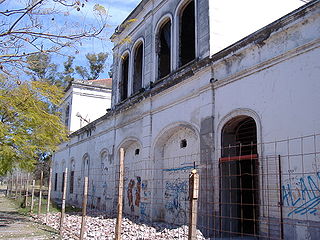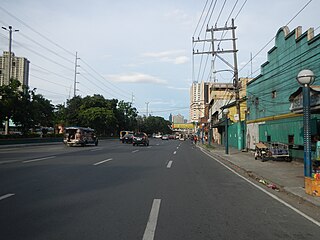| Senador Camará | |
|---|---|
| Neighborhood | |
| Coordinates: 22°54′16″S43°29′30″W / 22.90444°S 43.49167°W Coordinates: 22°54′16″S43°29′30″W / 22.90444°S 43.49167°W | |
| Country | |
| State | Rio de Janeiro (RJ) |
| Municipality/City | Rio de Janeiro |
| Zone | West Zone |
Senador Camará is a populous neighborhood in the West Zone of Rio de Janeiro, Brazil, with 111.231 residents (according to information of the Instituto Brasileiro de Geografia e Estatística - IBGE- Demographic Census of 2000) distributed in an area of 1,723.59 hectares, of lower class. It borders the neighborhoods of Bangu and Santíssimo.

Rio de Janeiro, or simply Rio, is the second-most populous municipality in Brazil and the sixth-most populous in the Americas. The metropolis is anchor to the Rio de Janeiro metropolitan area, the second-most populous metropolitan area in Brazil and sixth-most populous in the Americas. Rio de Janeiro is the capital of the state of Rio de Janeiro, Brazil's third-most populous state. Part of the city has been designated as a World Heritage Site, named "Rio de Janeiro: Carioca Landscapes between the Mountain and the Sea", by UNESCO on 1 July 2012 as a Cultural Landscape.

Brazil, officially the Federative Republic of Brazil, is the largest country in both South America and Latin America. At 8.5 million square kilometers and with over 208 million people, Brazil is the world's fifth-largest country by area and the fifth most populous. The capital is Brasília, and the most populated city is São Paulo. The federation is composed of the union of the 26 states, the Federal District, and the 5,570 municipalities. It is the largest country to have Portuguese as an official language and the only one in the Americas; it is also one of the most multicultural and ethnically diverse nations, due to over a century of mass immigration from around the world.

Bangu is a neighborhood in the West Zone of Rio de Janeiro, Brazil. It is a middle-class neighborhood. It is located in the western area of the city being one of the most populated districts, with 244,518 inhabitants [1] distributed in an area of 4570.69 ha. Located in the geographic center of the city, the neighborhood is close to Campo Grande, Senador Camará, Vila Aliança, Padre Miguel and Realengo. On November 22, 2004 the mayor of Rio de Janeiro César Maia created by decree the district Gericinó. The neighborhood was originally part of the neighborhood of Bangu, the region where the penitentiary of Bangu is located, besides Bangu dump. The region is where Gericinó was located containing the sub-district of the Aqueduct. Since 2004, the complex of Bangu and dump of Bangu, no longer belong to the neighborhood of Bangu.
The name originated from the railroad station that attends the neighborhood and is named "Estação Senador Camará" (Senador Camará Station in English), in honor of the Senator Otacílio de Carvalho Camará, that was the Senator of the Republic in 1919 and 1920.
The neighborhood is divided by the railway of the extension line of Santa Cruz, nowadays operated by the company SuperVia. On the left of the railway, on the direction to Santa Cruz, the neighborhood is cut by the Santa Cruz Avenue, that connects the neighborhoods of Realengo and Santa Cruz. On the right side, the neighborhood is cut by the Taquaral Roadway, that starts and finishes on the neighborhood of Senador Camará.

SuperVia Trens Urbanos is a Brazilian train operator founded in Rio de Janeiro in November 1998. It carries around 750 million passengers a year on a railroad network comprising 100 stations in 12 cities: Rio de Janeiro, Duque de Caxias, Guapimirim, Nova Iguaçu, Nilópolis, Mesquita, Queimados, São João de Meriti, Belford Roxo, Japeri, Paracambi and Magé.

Santa Cruz is an extensive and populous neighborhood of the high class, lower middle and low in the West Zone of the municipality of Rio de Janeiro, Brazil, the farthest from the center of Rio de Janeiro. Cut by the Santa Cruz extension of the urban passenger rail network of the metropolitan region of Rio de Janeiro, it has a very diverse landscape, with commercial areas, residential and industrial.










